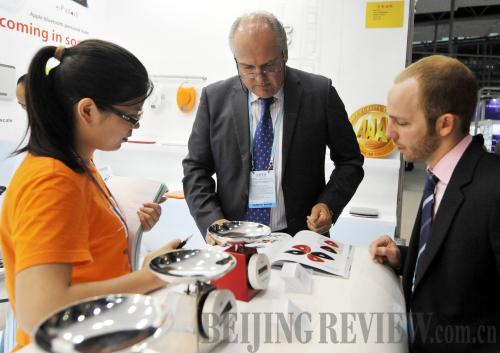|
 |
|
LESS CROWDED FAIR: Foreign buyers show interest in electronic scales at the 111th Canton Fair opened on April 15 in Guangdong Province. The first phase of the fair (April 15-19) registered a decrease in deal volume compared with the previous one (CHEN YEHUA) |

China's high-flying economy is starting to lose altitude. The big question is how China will rebalance its growth model to address major challenges and imbalances that come along with the economic growth deceleration. Louis Kuijs, Project Director of Hong Kong-based Fung Global Institute (FGI), shared his views in an article published on the FGI website. Edited excerpts follow:
China's economy is cooling and heading for slowed growth over the medium term. At the same time, China needs to adjust its growth pattern to address major challenges and imbalances. While there is little disagreement on these two points, views differ on the extent of the slowdown and the risks of a hard landing. There is also confusion over the key motivations for rebalancing and which rebalancing policies are essential. For rebalancing to be successful it is important to have appropriate motivations.
China is in for a moderate slowdown this year. Reflecting a soft global growth outlook, China's export prospects are subdued while the domestic economy is also slowing, led by real estate, as the government maintains its tight policy stance towards that sector. However, the deceleration in growth has been mild so far. Looking ahead, a declining inflation rate is giving more room for macroeconomic easing, with pure fiscal stimulus the preferred option. The government also has room to ease the stance toward the property sector once it considers its goal of reining in property prices has been achieved. As elsewhere, risks remain but this policy space makes a hard landing in China unlikely.
Looking at the medium-term drivers of growth, accumulation of labor and total factor productivity (TFP) are likely to decelerate because of demographics and declining scope for further productivity increases after impressive TFP growth over the past 20 years. Human capital accumulation could speed up somewhat but that would not be enough to offset downward pressures. Trying to offset these pressures by further hiking (physical) capital accumulation would not sit well with the government's rebalancing plans.
The trend toward slower growth, however, is not new and quite gradual. Assuming that fixed-investment growth comes down gradually to 6.6 percent by 2020, GDP growth would ease to an average of around 8 percent in 2012-20, compared to 10 percent in the past three decades. The government's official growth target of 7.5 percent for 2012, compared to 8 percent for previous years, caused a stir globally but should not have. It followed the lower growth targets in the 12th Five-Year Plan (2011-15) adopted last year. These targets are not binding in the sense of guiding the macro stance. Actual growth tends to exceed official targets, often by a large margin.
China needs to adjust its growth model since the current pattern has led to rising imbalances and is not sustainable. But what exactly are the key motivations? Some observers assert that China could soon hit a wall because of financial-economic problems centered on misallocated investment and escalating debt. How likely is this?
China's remarkably high investment—an estimated 48 percent of GDP in 2011—poses risks of wastage and compromising on standards, which seem to have risen due to the 2008-10 stimulus package. Overall, China's infrastructure investment has served the real economy well. Infrastructure utilization rates and standards compare favorably with those in other countries, while in the commercial sphere rates of return on investment also compare well.
On our estimates, economy-wide TFP growth was 3.1 percent in 1995-2011, after subtracting the contribution of human capital. This is high by international comparison and does not suggest large-scale misallocation of investment. China's incremental capital output ratio went up in recent years because of the investment-based stimulus package and rising share of infrastructure. But during the last five years the ratio was similar to that of India. The setting in which decisions on financing and investment are made in China raises risks of misallocation, which is why financial-sector and corporate governance is important. However, there are so far no convincing signs of systemic over-investment or misallocation. Moreover, with the capital-labor ratio around 15 percent of that in the United States in 2011, capital accumulation still has a long way to go.
| 